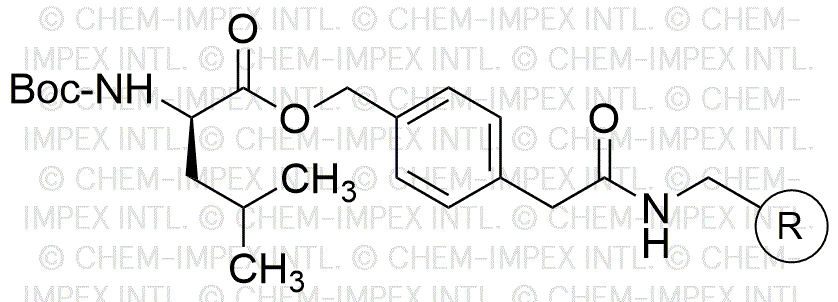Boc-D-leucine 4-oxymethylphenylacetamidomethyl is widely utilized in research focused on:
- Peptide Synthesis: This compound serves as a key building block in the synthesis of peptides, particularly those requiring D-amino acids, enhancing the stability and bioactivity of the resulting peptides.
- Drug Development: In pharmaceutical research, it is used to create novel drug candidates, especially in the development of therapeutics targeting specific biological pathways, improving efficacy and reducing side effects.
- Bioconjugation: The compound is applied in bioconjugation processes, allowing researchers to attach biomolecules to drugs or imaging agents, which can enhance targeting and delivery in therapeutic applications.
- Research on Protein Folding: It aids in studies related to protein folding and stability, providing insights into the behavior of proteins in various environments, which is crucial for understanding diseases.
- Material Science: In material science, it is utilized to modify surfaces and create functional materials, contributing to advancements in drug delivery systems and biomaterials.
General Information
Properties
Safety and Regulations
Applications
Boc-D-leucine 4-oxymethylphenylacetamidomethyl is widely utilized in research focused on:
- Peptide Synthesis: This compound serves as a key building block in the synthesis of peptides, particularly those requiring D-amino acids, enhancing the stability and bioactivity of the resulting peptides.
- Drug Development: In pharmaceutical research, it is used to create novel drug candidates, especially in the development of therapeutics targeting specific biological pathways, improving efficacy and reducing side effects.
- Bioconjugation: The compound is applied in bioconjugation processes, allowing researchers to attach biomolecules to drugs or imaging agents, which can enhance targeting and delivery in therapeutic applications.
- Research on Protein Folding: It aids in studies related to protein folding and stability, providing insights into the behavior of proteins in various environments, which is crucial for understanding diseases.
- Material Science: In material science, it is utilized to modify surfaces and create functional materials, contributing to advancements in drug delivery systems and biomaterials.
Documents
Safety Data Sheets (SDS)
The SDS provides comprehensive safety information on handling, storage, and disposal of the product.
Product Specification (PS)
The PS provides a comprehensive breakdown of the product’s properties, including chemical composition, physical state, purity, and storage requirements. It also details acceptable quality ranges and the product's intended applications.
Certificates of Analysis (COA)
Search for Certificates of Analysis (COA) by entering the products Lot Number. Lot and Batch Numbers can be found on a product’s label following the words ‘Lot’ or ‘Batch’.
*Catalog Number
*Lot Number
Certificates Of Origin (COO)
This COO confirms the country where the product was manufactured, and also details the materials and components used in it and whether it is derived from natural, synthetic, or other specific sources. This certificate may be required for customs, trade, and regulatory compliance.
*Catalog Number
*Lot Number
Safety Data Sheets (SDS)
The SDS provides comprehensive safety information on handling, storage, and disposal of the product.
DownloadProduct Specification (PS)
The PS provides a comprehensive breakdown of the product’s properties, including chemical composition, physical state, purity, and storage requirements. It also details acceptable quality ranges and the product's intended applications.
DownloadCertificates of Analysis (COA)
Search for Certificates of Analysis (COA) by entering the products Lot Number. Lot and Batch Numbers can be found on a product’s label following the words ‘Lot’ or ‘Batch’.
*Catalog Number
*Lot Number
Certificates Of Origin (COO)
This COO confirms the country where the product was manufactured, and also details the materials and components used in it and whether it is derived from natural, synthetic, or other specific sources. This certificate may be required for customs, trade, and regulatory compliance.

